Outbound Marketing: How to Do It & Why It Matters
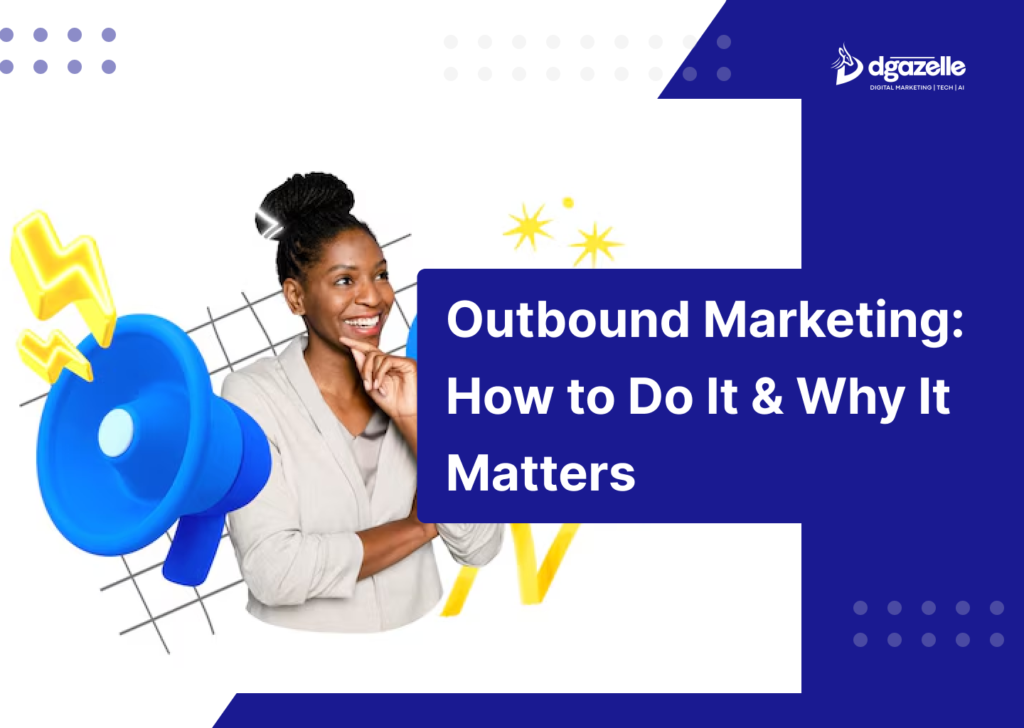
Outbound marketing is a proactive strategy where businesses reach out to potential customers rather than waiting for them to discover their brand. This includes traditional methods like TV commercials, radio ads, cold calls, and billboards, as well as digital approaches such as email marketing, influencer collaborations, paid social media ads, and retargeting campaigns. Unlike inbound marketing where customers find your business through content like blogs or SEO outbound marketing pushes your message to a broad audience, sometimes interrupting their daily activities. That’s why it’s often called “push marketing” or “interruption marketing.” However, when done right, outbound marketing helps businesses build brand awareness, engage the right audience, and drive sales. The key is strategic execution choosing the right channels, refining your message, and ensuring your brand appears in front of the right people at the right time. For Nigerian businesses, a well-crafted outbound marketing campaign, paired with a high-converting website can be a game changer. That’s where Dgazelle’s web design services come in. A well-optimized website makes your outbound efforts more effective by ensuring your ads drive traffic to a professional, high-performing online presence. Why Outbound Marketing Is Important Inbound marketing is powerful, but let’s be real—if people don’t know your product or service exists, they won’t search for it. Outbound marketing ensures your business gets in front of the right audience, whether they’re actively looking or not. Here’s why outbound marketing still matters for Nigerian businesses: For the best results, combine outbound efforts with a strong online presence. A high-converting, well-optimized website—like those crafted by Dgazelle—ensures that your outbound traffic turns into paying customers. Outbound Marketing Strategies Success in marketing isn’t about using just one strategy—it’s about a mix of tactics that help you reach your target audience at different touchpoints. Here are five outbound marketing strategies that can boost your brand’s visibility and customer engagement in Nigeria. 1. Cold Email Cold emails can feel intrusive, but when done right, they’re a powerful lead-generation tool. The key is personalization. Instead of generic pitches, craft emails that offer real value, address specific pain points, and show how your solution fits their needs. 2. Search Ads Paid search ads place your business in front of potential customers at the right moment. Whether it’s Google Ads or Bing Ads, search advertising delivers instant visibility, measurable ROI, and high-intent traffic to your website. 3. Social Media Ads With social media usage soaring in Nigeria, platforms like Facebook, Instagram, and TikTok offer cost-effective paid advertising. Since organic reach is declining, investing in social media ads ensures your brand stays visible, engages your audience, and drives conversions. From cold emails to paid ads, we create outbound campaigns that convert. Elevate your brand’s visibility and drive real growth. Start Your Campaign Now! 4. Outreach Marketing Reaching out to the right influencers, industry leaders, and media outlets boosts credibility and brand awareness. Whether it’s through email outreach, PR campaigns, or influencer partnerships, this approach helps build trust and authority in your industry. 5. Content Syndication Repurposing content on platforms like Medium, LinkedIn, and Quora extends your reach beyond your website. Paid syndication tools like Outbrain help push your content to larger audiences, maximizing visibility. Pro Tip: No matter which outbound strategy you choose, your website must be optimized for conversions. Dgazelle helps businesses create high-performing websites that turn traffic into customers. 6. Trade Shows & Events While digital marketing dominates today’s landscape, in-person events still hold value. Attending trade shows and industry events puts your brand directly in front of a highly targeted audience. For example, Nigerian businesses in real estate can leverage property expos, while tech startups can attend industry conferences to network and generate leads. To maximize ROI, track event metrics like footfall, lead capture, and conversions, then follow up with personalized emails. 7. Cold Calls Cold calling may seem outdated, but it remains effective. The key is shifting from pushy sales scripts to meaningful conversations. Strategies like SPIN selling—where you ask prospects structured questions to uncover their pain points—can improve success rates. 8. Traditional Media Advertising Despite the rise of digital marketing, TV, billboards, radio, and print ads still drive brand awareness. Nigerians still consume traditional media heavily, making it a great complement to online efforts. Pro Tip: Ensure your digital presence is strong. Dgazelle creates websites optimized for conversions, ensuring every outbound lead has a seamless experience. Merging Inbound and Outbound Marketing As we detailed earlier, there are some main differences between inbound and outbound marketing. Inbound marketing is when a customer comes to you first, and outbound is more about pushing your message to potential leads, but the two can work together. For example, people might sign up for your mailing list or a white paper, but you start the conversation with an outbound marketing strategy through advertising, cold calling, or email. Although they’re very different strategies, you can mix them up to reach more people by: Conclusion: Why Outbound Marketing Still Matters Marketing is competitive, and waiting for customers to find you isn’t always enough. Outbound strategies usually cold emails, search ads, social media ads, trade shows, and traditional media help boost visibility and drive engagement. Outbound marketing remains relevant today, complementing inbound efforts to strengthen brand growth. However, the key is understanding your audience and delivering value. When done right, outbound marketing becomes a powerful tool in your overall strategy. Don’t just wait for customers to find you—put your brand in front of them! Let’s craft an outbound marketing strategy that drives results. Get a Free Strategy Session Today!
From Tales by Moonlight to TikTok: The Power of Nostalgia Marketing in Modern Nigerian Marketing
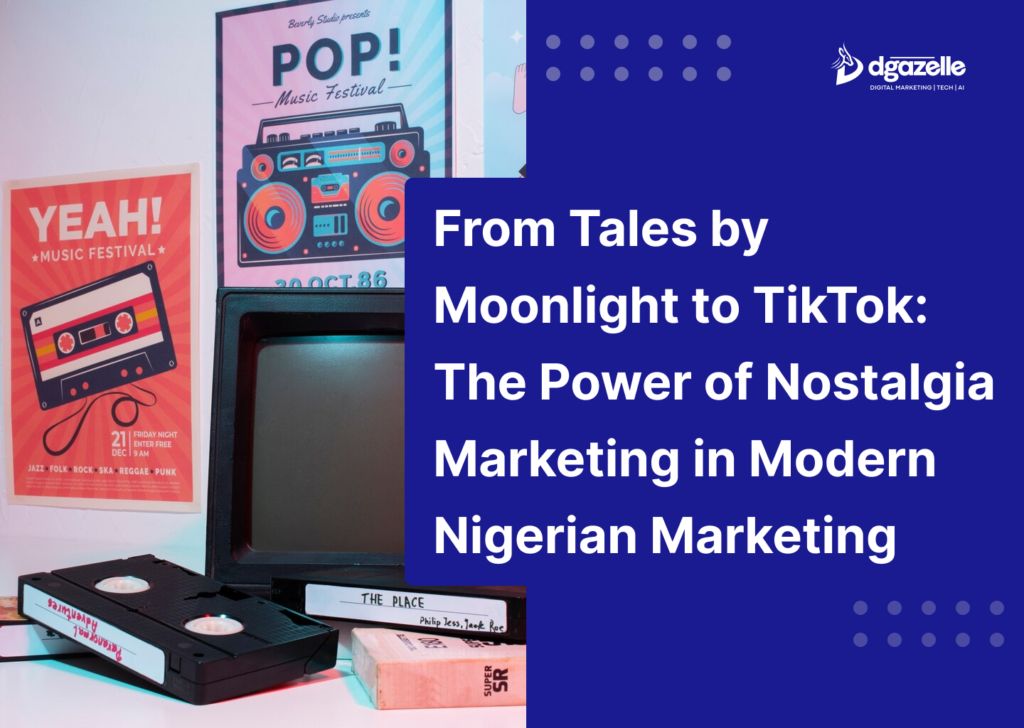
Ever found yourself smiling at an old commercial jingle or reminiscing about Tales by Moonlight? That’s nostalgia marketing at work! It taps into deep emotions linked to cherished memories, instantly creating a bond between your brand and your audience. But nostalgia marketing is more than just a sentimental trip down memory lane—it’s a powerful tool to drive engagement, loyalty, and sales. Nigerians love nostalgia, whether it’s the music of Plantashun Boiz, Super Story reruns, or childhood snacks like Baba Dudu and Goody Goody. As a small business, you can tap into these collective memories to connect with your audience in an authentic and emotionally compelling way. Let’s explore how nostalgia marketing works and why it’s a game-changer for Nigerian brands. What Is Nostalgia Marketing? Nostalgia marketing is a strategy that connects your brand to past memories, creating an emotional bond with your audience. It taps into shared experiences—whether it’s childhood TV shows, classic snacks, or old-school fashion trends—to spark feelings of joy and familiarity. Think of how Nigerians light up when they hear Tales by Moonlight mentioned or see a pack of Okin Biscuit. That’s nostalgia in action! Big brands use this by bringing back retro packaging (like Coca-Cola’s classic bottle design) or reviving old-school trends. For Nigerian small businesses, nostalgia marketing can be a game-changer. Whether it’s referencing old Nollywood films, vintage Naija pop culture, or throwback slang (way back when “No wahala” was the go-to phrase!), you can use nostalgia to create content that resonates deeply with your audience. Why Does Nostalgia Marketing Work? Nostalgia marketing is powerful because it offers comfort and familiarity, especially in uncertain times. It transports people to the “good old days,” providing a sense of stability and joy. Research even suggests that nostalgia helps with emotional well-being, making people feel more connected and secure. For Nigerian small businesses, nostalgia marketing is an opportunity to tap into shared cultural moments. Whether it’s the days of Papa Ajasco, Superstory, or the original MTN “Y’ello” commercials, these memories trigger strong emotions and connections. Nostalgia is also social—it creates conversations, bonding people over collective experiences. Even though nostalgia feels personal, it has mass appeal. When a campaign reminds people of their childhood snacks (Gala and La Casera, anyone?), school days, or early social media experiences (2go and Facebook pokes!), it resonates deeply. It builds trust, strengthens brand loyalty, and—when done right—translates into higher engagement and sales. Want to craft a nostalgia marketing campaign that resonates? Our digital marketing experts help brands connect with audiences through emotional storytelling. Let’s create your winning strategy today How Does Nostalgia Marketing Work? Nostalgia marketing taps into deep emotions, triggering feelings of joy, security, and familiarity. When people recall the “good old days,” they associate those memories with happiness—creating a powerful emotional bond with a brand. For Nigerian Millennials and Gen X, nostalgia feels like comfort food for the brain. In a rapidly changing, often chaotic world, throwbacks to simpler times (remember when Nokia 3310 was king?) offer a welcome escape. Research even shows that nostalgia boosts emotional satisfaction, increasing brand loyalty and spending. Beyond personal memories, nostalgia is social. A shared love for Tales by Moonlight or Super Strikas creates instant community. To tap into this, brands can use: By incorporating these, small businesses can create campaigns that resonate emotionally, boosting engagement and conversions. Tips for Implementing Nostalgia Marketing Nostalgia marketing can help brands create an emotional connection with their audience. Here are practical ways to incorporate it effectively: 1. Know Your Audience To trigger nostalgia successfully, you must understand your target audience and their emotional connections to the past. Different generations have distinct cultural references that resonate with them. To refine your approach, research: Example: A Nigerian fashion brand targeting Millennials could bring back bootcut jeans and Rocawear-inspired outfits, while a beverage company could revive classic soft drink packaging. Nostalgia is powerful—but only when done right. Our agency combines data-driven insights with creative storytelling to boost engagement and conversions. Let’s bring your brand’s past to life! 2. Leverage Social Listening People constantly share nostalgic moments online. By tracking these conversations, brands can identify trending nostalgic topics and incorporate them into marketing campaigns. How to stay ahead of nostalgia trends: Example: If “Palm wine tapper movies” trends in Nigeria, a beverage brand could create content referencing Sam Loco Efe or Aki and Pawpaw to connect with older audiences. 3. Tap Into Company History If your company has been around for a while, revisiting past branding elements can stir nostalgia and attract both new and returning customers. Ways to leverage brand history: Example: Fan Milk Nigeria recently revived its Fan Ice branding, triggering nostalgia among Nigerians who grew up buying it from street vendors. Conclusion Nostalgia marketing is a powerful tool, but it requires a thoughtful approach to be truly effective. It’s not just about using retro visuals or catchy throwback references—it’s about strategically tapping into the emotional connections your audience has with the past. To create an impactful nostalgia-driven campaign, start by identifying the cultural moments, trends, and experiences that shaped your target audience. Whether it’s a particular song, a childhood snack, or a vintage tech gadget, these elements should evoke a sense of familiarity and comfort. However, nostalgia should not feel outdated; instead, it should be reimagined in a way that resonates with today’s consumers. The key to success is balance: blending the past with the present to create something fresh yet familiar. When done right, nostalgia marketing fosters engagement, strengthens brand loyalty, and turns sentimental memories into meaningful connections that drive action. Reimagine the past with a fresh twist! We design nostalgia-infused campaigns that spark emotions and drive results. Let’s make your brand unforgettable.
Marketing Budget Crisis? 7 High-Impact Strategies That Cost Nothing

For small businesses, every Naira counts. Marketing on a tight budget requires creativity and smart strategies to maximize your resources without sacrificing effectiveness. The great news? There are several low-cost strategies that can help you reach your target audience and increase engagement without breaking the bank. As Nigerian SMEs, we understand that both time and money are limited resources. That’s why we’ve put together a list of practical, budget-friendly tactics that are not only easy to implement but also incredibly impactful. Whether you’re just starting your business or looking to refresh your marketing approach, these strategies will help you make the most of your marketing spend and grow your business—no matter the size of your budget. In fact, The CMO Survey revealed that 42% of Chief Marketing Officers (CMOs) are dealing with marketing budget cuts. But despite these challenges, businesses are still finding ways to adapt and thrive with cost-effective solutions. This article dives into the most effective strategies for Nigerian business owners who are navigating budget constraints, helping you make every Naira you spend work harder for your business. Marketing budget and Clear Marketing Goals When you’re facing a marketing budget crunch, setting clear goals and priorities becomes a game-changer. It’s about making every Naira work harder for you. Rather than spreading your resources thin across various activities, you need to laser-focus on what truly matters to drive growth and success. So, how can you set the right marketing goals for your business? Here’s a step-by-step guide: Focusing on high-impact, low-cost activities is key to achieving maximum results. At Dgazelle, we help businesses refine goals, target the right audience, and streamline processes to make the most of limited marketing budgets. Reach out today to start optimizing your strategy! 1. Leverage Social Media Platforms Social media is a powerful, low-cost marketing tool that allows you to reach a wide audience. Platforms like Instagram, Facebook, Twitter, and LinkedIn offer free accounts for businesses to build their presence and engage with their audience. By consistently posting valuable content, responding to customer inquiries, and using hashtags effectively, you can gain traction without spending a penny. You can also join relevant groups or communities to increase visibility and engage with your target audience directly. 2. Create Valuable Content Creating valuable content is a powerful way to attract new customers and position your business as an authority in your industry. Whether it’s blog posts, e-books, whitepapers, or videos, providing useful and relevant information will keep your audience engaged. The best part? It’s cost-effective and builds long-term value. By consistently sharing this content on your social media platforms and website, you increase visibility and drive organic traffic. To make the most of your content, balance between gated (premium) and non-gated (free) content. Gated content allows you to capture leads, while non-gated content nurtures broader engagement and establishes trust. Whatever approach you chose to use, ensure to optimize your content for SEO with simple practices like using keywords, internal linking, and creating shareable content. Or better still outsource it to dedicated marketing agency like Dgazelle 3. Email Marketing Email marketing remains one of the most powerful tools for small businesses on a tight budget. By building an email list and sending regular, valuable content to your subscribers, you can nurture relationships and drive repeat business. Platforms like Mailchimp offer free plans for small lists, which means you can get started without any upfront cost. Use segmentation to send personalized, targeted messages to different parts of your audience to increase open and click-through rates. 4. Collaborate with Influencers (Micro-Influencers) While working with big influencers might be out of reach, micro-influencers (those with smaller, highly engaged followings) often offer affordable or even free collaboration opportunities. Micro-influencers are typically open to partnerships in exchange for free products, services, or exposure. This tactic can help you tap into a new audience and build credibility at little to no cost. Remember to choose influencers whose followers match your target demographic to maximize the effectiveness of your campaigns. 5. Offer Discounts and Promotions Offering discounts and promotions is a highly effective way to attract new customers while encouraging repeat business. Whether it’s a special discount for first-time buyers or a loyalty program for returning customers, these offers can motivate potential customers to take action and increase retention. Promotions are also a great way to generate urgency and boost sales, especially if you time them with holidays or special events. Loyalty programs, on the other hand, help build long-term relationships with customers, fostering brand loyalty and increasing the lifetime value of each client. At [Dgazelle Digital], we understand how impactful these strategies can be, and we can help you design the perfect promotions and loyalty programs that align with your business goals. By offering the right incentives, you not only attract new customers but also ensure they keep coming back, all while working within your budget to maximize returns. 6. Referral Programs A referral program can be an incredibly cost-effective way to increase your customer base. By offering existing customers incentives (such as discounts or freebies) for referring others, you can generate new leads with minimal investment. Word-of-mouth marketing remains a powerful tool, especially when customers are motivated by rewards. Ensure to keep the process simple and the reward is attractive enough for customers to want to participate. 7. Networking and Partnerships Networking and building partnerships with other small businesses or professionals in your industry can open doors to valuable marketing opportunities. Attend local events, participate in online forums, and collaborate with businesses that complement your products or services. By sharing each other’s audiences, you can expand your reach without spending any money. You can use LinkedIn to connect with potential business partners and influencers in your industry. Conclusion Marketing on a tight budget doesn’t mean you have to compromise on quality or effectiveness. By leveraging these strategies, small businesses can make the most of their limited resources and still drive significant growth. Whether it’s through organic social media marketing, content creation, or
How Marketers Are Spending Their Money in 2025
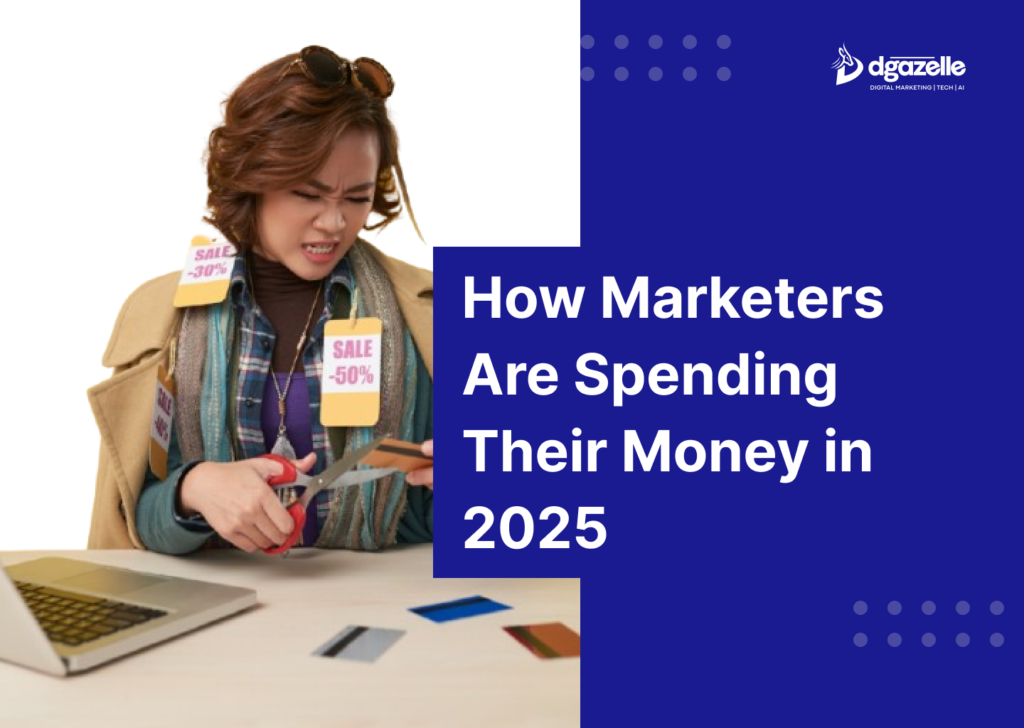
In today’s rapidly evolving digital landscape, making informed decisions about marketing spend has never been more crucial. As we navigate through 2025, businesses face a transformed marketing environment shaped by sophisticated Google algorithm updates, AI-powered solutions, and shifting consumer behaviors. The question isn’t just about where to spend your marketing budget – it’s about making investments that deliver measurable results. A comprehensive analysis of marketers across diverse industries, reveals fascinating insights into how successful businesses are adapting their marketing strategies for 2025. With inflation rates stabilizing and significant geopolitical shifts influencing market dynamics, we’re seeing innovative approaches to budget allocation that might surprise you. Factors Impacting Digital Marketing Investment When marketers plan their budgets, several factors influence their spending decisions. According to survey, the top three factors shaping marketing investments for 2025 are: Let’s dive deeper into these factors and what they mean for your strategy. Though budgets are rising, companies remain cautious about spending. The focus is on proven strategies like SEO, PPC, and email marketing — channels that offer high ROI and predictable results. Market trends and competition also influence decisions. Businesses are keeping a close eye on competitors while gradually adopting new technologies like AI, automation, and omnichannel marketing to stay relevant. To optimize your budget: Balancing stability with innovation will help businesses thrive in 2025. So, what marketing strategies are these budgets funding? Let’s take a look How Marketers Are Allocating Their Budgets in SEO and Organic Social for 2025 According to Neil Patel, 44% of marketers plan to increase their SEO budget in 2025, with the primary reason being that SEO is still thriving despite AI’s impact on search results. Most marketers believe AI-driven search hasn’t significantly reduced traffic, making SEO a safe and profitable channel. Meanwhile, 39% plan to maintain their current SEO budget because it’s already delivering results. For the 17% reducing SEO budgets, the reasons are linked to: Organic Social Spending 25% of marketers plan to increase their organic social budgets, citing its value in building brand awareness and fostering long-term relationships — even if it doesn’t always drive direct conversions. 17% will keep their organic social budget the same, acknowledging that social media is still where the attention is and remains a vital communication tool for customer engagement. Content Creation A significant 63% of marketers plan to increase their content creation budgets in 2025. The top reasons are: Meanwhile, 33% will maintain their current budgets, seeing the value in repurposing content across different campaigns and formats. AI SEO A staggering 97% of marketers plan to invest in optimizing for AI-driven platforms like ChatGPT and SearchGPT, recognizing these tools as valuable discovery channels. Only 2% will keep their AI SEO budget steady, while a mere 1% will reduce investment, citing limited returns from AI recommendations so far. Email Marketing Despite being a long-standing digital marketing channel, 28% of marketers plan to increase their email marketing budget in 2025. The main reasons include: Meanwhile, 59% will maintain their current budget, noting that email marketing consistently drives sales and engagement. However, 13% plan to reduce their email marketing spend, often due to switching vendors or scrubbing email lists to cut costs. Paid Social Ads X (formerly Twitter) leads the way, with 55% of marketers planning to increase their ad budget. The primary reasons are Affordable ad rates. and Increased political neutrality, encouraging more brands to engage. For other platforms, the reasons for maintaining ad spend vary: Exploring Other Ad Channels in 2025 Marketing Spend The increasing budgets for podcasting, influencer marketing, and connected TV (CTV) align with audience shifts toward these channels. However, the remarketing budget jump of 89% stood out as a surprising trend. Why the surge? Remarketing strategies help brands make cold traffic warmer, reducing initial ad costs. Instead of focusing solely on cold leads, marketers now run ads to engage content and then remarket to those who’ve shown interest, improving conversion rates. However, some ad channels are seeing budget cuts due to economic factors or lower-than-expected ROI. For influencer marketing, budget decreases often stem from internal management pains and labor costs associated with maintaining multiple influencer relationships. While influencer campaigns are impactful, the time and resources required to manage them can be daunting. Overall, marketers are being more strategic, focusing on cost-effective methods to maximize ad performance and improve long-term returns. What Does This Mean for Me? Based on the research, paid search marketing, organic strategies, and email marketing top the list of channels marketers plan to invest in for 2025. Companies are balancing immediate returns with sustainable growth, prioritizing proven strategies in response to economic uncertainty. Let’s break down how each leading strategy contributes to your business goals: The message is clear:Spend wisely. Focus on what works. Experiment within reason. Conclusion Despite economic challenges, marketers are optimistic about 2025, with many choosing to increase or maintain their budgets across proven channels like SEO, paid ads, email marketing, and remarketing. This optimism is driven by declining inflation and lowering interest rates, signaling improved market conditions ahead. Businesses are playing it safe by prioritizing high-ROI strategies and balancing short-term returns with long-term brand growth. The focus remains on maximizing existing resources, targeting sustainable channels, and staying ahead of competition by adapting to market trends. At Dgazelle, we offer data-driven digital marketing strategies tailored to your business needs. Whether it’s SEO, paid ads, or email marketing, we focus on delivering measurable results. Get in touch today and maximize your marketing budget and grow your business in 2025!
Marketing KPIs and Metrics: Everything You Need to Know To Start Leveraging it

We are in a data-driven marketing landscape and Key Performance Indicators (KPIs) are the benchmarks that measure the effectiveness of your strategies. They provide a clear framework to evaluate success, identify trends, and shape future campaigns. Marketing KPIs are quantifiable metrics designed to assess a company’s long-term performance. They gauge strategic, financial, and operational achievements, offering a comparative lens to evaluate your business against competitors and past benchmarks. Digital channels like websites, social media, and online stores generate vast amounts of data—from visitor counts to ROI over years. Without a structured approach to tracking and analyzing these numbers, businesses risk losing valuable insights and opportunities. Fortunately, strategic data tracking makes sense of the numbers, transforming them into actionable insights. Whether it’s refining website content to boost traffic or using historical data to craft a five-year growth plan, marketing KPIs unlock the potential hidden in your data. Understanding Key Performance Indicators (KPIs) Key Performance Indicators (KPIs) are measurable metrics that evaluate progress toward specific business goals. They serve as a compass, guiding organizations to assess their performance and make data-driven decisions. Whether comparing results to industry benchmarks, past performance, or set targets, KPIs provide valuable insights into the effectiveness of strategies. KPIs vary across industries and businesses, reflecting unique priorities and goals. For example, a software company might prioritize year-over-year revenue growth, while a retail chain could focus on same-store sales. These metrics must align with organizational objectives to deliver meaningful insights. Central to KPIs is data collection, storage, and analysis. By synthesizing data and comparing it against benchmarks, organizations can determine the efficacy of current systems and make necessary adjustments. The ultimate goal of KPIs is to present results clearly, empowering management to make informed strategic decisions. Marketers must select KPIs relevant to their campaigns and objectives. Metrics like website traffic, conversion rates, customer acquisition costs, and lifetime value are commonly used to evaluate performance. For instance, tracking website traffic as a KPI can reveal whether marketing efforts successfully drive visitors, enabling teams to refine strategies for better outcomes. By leveraging KPIs, businesses can measure success, optimize campaigns, and achieve their goals effectively. KPIs serve multiple purposes: It’s worth noting that while there are common KPIs used across the industry, such as click-through rates or conversion rates, the most effective KPIs are often those tailored to a company’s unique goals and market position. Selecting the right KPIs requires a deep understanding of both the brand’s objectives and the nuances of its target audience. Types of Marketing KPIs Marketing KPIs vary based on the channel, campaign goals, or industry, providing critical insights into performance. Here are common types: Classification by Data Type: Selecting the right mix of these KPIs ensures a balanced and actionable approach to marketing success. Setting the Right Marketing KPIs Choosing the right marketing KPIs is essential for measuring the success of your strategies and making data-driven decisions. Here’s how to ensure your KPIs effectively drive results: By aligning KPIs with objectives, ensuring relevance, and balancing perspectives, you can optimize campaigns to achieve both immediate and lasting success. Monitoring and Analyzing Marketing KPIs Tracking Key Performance Indicators (KPIs) is an essential aspect of any marketing campaign. KPIs help you measure your marketing efforts’ success and identify areas that need improvement. However, tracking KPIs alone is not enough; you also need to analyze the data gathered to make informed decisions. Employing the following methods can help you make the most of your KPI analysis: Establishing a KPI Tracking System Having a system to track your KPIs enables you to monitor your marketing campaigns’ performance systematically. You can use various tools and software to automate the tracking process and provide detailed reports for analysis. An effective KPI tracking system should include: With a reliable KPI tracking system in place, you can easily identify areas that need improvement and make informed decisions to optimize your marketing campaigns. Regularly Reviewing and Adjusting KPIs Marketing is a dynamic field, and trends and consumer behavior are ever-changing. Regularly reviewing your KPIs ensures that your metrics remain relevant and support your current business objectives. Adjusting your KPIs allows you to stay on top of the game and improve your marketing strategy. When reviewing and adjusting your KPIs, consider: By regularly reviewing and adjusting your KPIs, you can ensure that your marketing campaigns remain relevant and effective. Utilizing Data Visualization Tools for KPI Analysis Data visualization tools help simplify complex data and present it in a way that is easy to understand. They enable you to identify trends and patterns in your data and make informed decisions to improve your marketing campaigns. Some popular data visualization tools include: With the help of data visualization tools, you can easily analyze your KPIs and identify areas that need improvement. You can also create visually appealing reports to share with your team and stakeholders. Conclusion Effective KPI monitoring and analysis can significantly improve the effectiveness of your marketing strategy. It provides you with the necessary insights required to make data-driven decisions and optimize your marketing campaigns for better results. Employ the tips discussed in this article to leverage KPIs to measure marketing strategy effectiveness and drive your business towards success. Ready to turn insights into impact? Let Dgazelle redefine your marketing strategy with data-driven solutions that deliver results. Contact us today to unlock your brand’s full potential!
5 Marketing Strategies That Will Skyrocket Your Sales in 2025
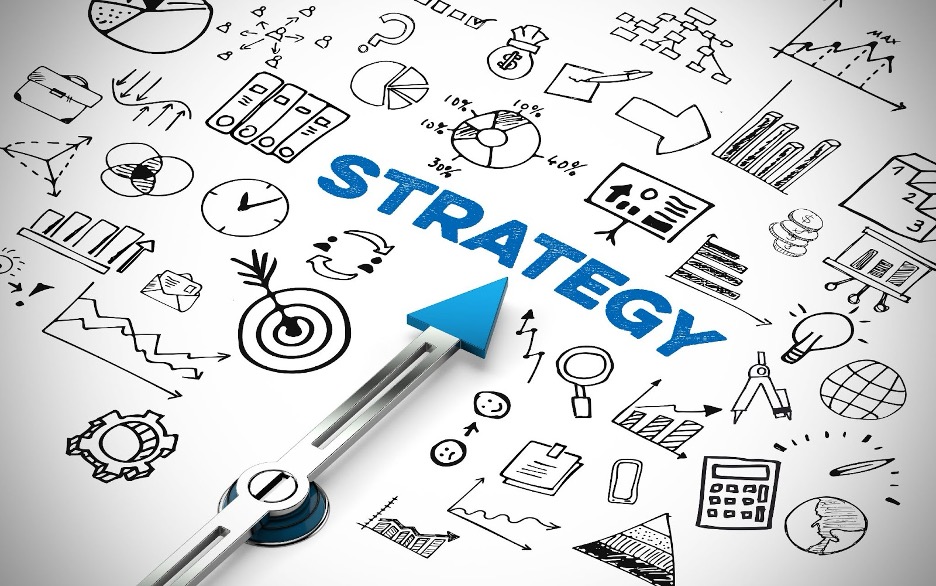
As we approach 2025, the marketing landscape is evolving rapidly, driven by AI, data-driven tactics, and a shift in consumer behavior. The old strategies won’t cut it anymore. Personalization, automation, and video content are becoming crucial tools for engagement, while immersive content and brand influencers are gaining traction to capture attention in an increasingly noisy digital world. Consumers crave authenticity, making storytelling an essential aspect of any campaign. The strategies that worked in the past won’t get you the results you need in 2025. To stay ahead, you need to adopt innovative marketing approaches that leverage AI, personalized experiences, and impactful content. This year is your opportunity to break through the noise, engage more effectively with your audience, and propel your sales to new heights. Ready to skyrocket your sales in 2025? Keep reading to discover the five key strategies that will drive your business forward. Reason For A Solid Marketing Strategy In 2025 A well-designed marketing strategy is the cornerstone of any thriving business. It aligns your brand with its objectives, steers your content, and keeps you competitive in a dynamic market. A crucial element in developing this strategy is the marketing funnel, which outlines the stages a potential customer goes through: awareness, consideration, decision, and retention. A robust strategy helps guide prospects through these phases, enhancing conversion rates and fostering long-term loyalty. Without a clear plan, businesses risk wasting resources and missing out on growth opportunities. By embracing emerging trends within your marketing funnel, you can stay ahead of the curve, effectively reach your audience, and drive innovation and growth. Let’s dive into the top marketing strategies to adopt in 2025 and position your business for success. Video: The Cornerstone of Modern Marketing In a world where the average person is exposed to over 6,000 ads daily, capturing attention is a major challenge. Video is a dynamic, engaging format that stands out. Here’s why it’s so effective: How to Leverage Video Effectively AI for Content Marketing and SEO in 2025 In the past year, AI has transitioned from a futuristic concept to an integral tool in content marketing and SEO. In 2025, AI will continue to transform how businesses operate by enhancing efficiency and personalizing customer experiences. AI analyzes vast amounts of data to help brands deeply understand their audiences and predict trends. Tools like AI-powered chatbots, content generators, and predictive analytics streamline processes, enabling businesses to create tailored content at scale and improve search rankings. For SEO, AI helps content rank higher by analyzing search engine algorithms, user behavior, and keyword performance. Platforms like HubSpot and Jasper.ai allow businesses to create content aligned with user preferences, boosting engagement and driving conversions. However, while AI-generated content can be a powerful tool, Google still prioritizes unique, human-written content. As AI reshapes search results, SEO tactics must adapt. With 28% of Google searches now featuring AI-generated overviews, businesses must focus on niche topics and structure content to answer questions concisely, incorporating multimedia for better engagement. Building high-quality backlinks and optimizing for voice search will also be key in 2025. As AI agents become more influential in decision-making, optimizing for AI-driven systems will ensure your content’s visibility in an increasingly automated world. Building Authority Through Personality-Driven Marketing In a crowded market full of faceless corporations, consumers seek genuine human connections. Brands that put a real person at the forefront build trust and make their brand more approachable and memorable. Studies show that human faces drive engagement, with people forming first impressions in just 100 milliseconds. Trust is also crucial—81% of consumers say trust influences their purchase decisions, and a recognizable face can bridge that gap. Brands with a human presence experience better recall, increased loyalty, and stronger customer relationships. Personal interactions foster emotional connections, making customers feel safer and more comfortable with your brand. To activate your brand’s personality, humanize your messaging with authentic storytelling and a consistent, relatable voice. Feature key individuals like CEOs or team members in blogs or public engagements. Launch podcasts or video series to offer valuable content and interact directly with your audience. On social media, let key personnel share insights and behind-the-scenes content to foster engagement. Leverage testimonials and user-generated content to add authenticity. Remember, emotionally connected customers are significantly more valuable. By being transparent, consistent, and interactive, you can create lasting relationships that drive loyalty and growth for your brand. Data-Driven, Personalized Marketing Consumers today demand more than generic marketing; they expect content that caters to their specific needs and preferences. This is where data-driven personalization comes in. It allows businesses to create tailored experiences at every stage of the buyer’s journey. By collecting first-party data such as browsing behavior, purchase history, and customer preferences, marketers gain valuable insights into consumer behavior. This information enables them to deliver hyper-targeted campaigns that resonate with individual users. Personalization goes beyond digital ads—it’s also seen in customized emails, product recommendations, and personalized website experiences. By using data to create these tailored interactions, businesses can enhance user engagement, stay ahead of competitors, and ultimately boost conversions. Leading brands like Netflix and Spotify have mastered data-driven personalization, offering content recommendations that keep users engaged longer. As consumers become increasingly accustomed to personalized experiences, businesses that leverage data will continue to thrive. Personalization allows brands to connect more deeply with their audience, fostering loyalty and increasing the likelihood of repeat business. Data-driven personalization is no longer a trend—it’s a fundamental strategy for success in 2025 and beyond. Create Stories Worth Sharing The Power of Storytelling: Storytelling has always been a fundamental part of human communication, from ancient cave paintings to today’s digital media. It’s how we understand the world, share knowledge, and connect with others. Stories are more than entertainment—they evoke emotions and help build connections, making them an essential tool in marketing. Emotional and Memory Impact: Stories engage emotions, enhancing their power and memorability. When we hear a story, our brains release oxytocin, which fosters trust and empathy. Research by Stanford University found that stories are 22 times
Email Drip Campaigns: What it Means and How to Successfully Create One
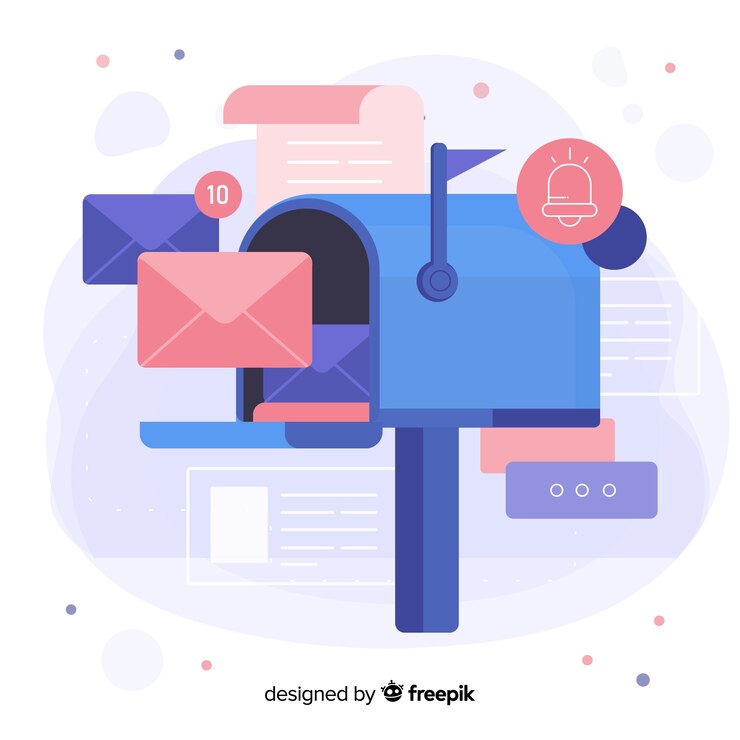
Email marketing is one of the most powerful tools for engaging with and learning about your customers. Among its many strategies, and email drip campaigns among others stand out for their effectiveness and simplicity. Drip campaigns are automated emails sent based on specific actions or schedules, helping you nurture leads, onboard new customers, or even turn occasional buyers into loyal ones. Whether it’s a series of welcome emails or reminders to complete a purchase, drip campaigns allow businesses to maintain meaningful and personalized communication without manual effort. By the end, you’ll have a complete understanding of how to use email drip campaigns to boost customer engagement and improve marketing results. What is an Email Drip Campaign? An email drip campaign, also known as automated marketing or an automated email campaign, is a sequence of pre-written emails sent automatically to recipients based on specific triggers or schedules. The goal of a drip campaign is to deliver tailored and timely content to the right person, fostering engagement and driving desired actions like purchases or sign-ups. For instance, someone who subscribes to your mailing list might receive a welcome email, while a visitor lingering on your products page without purchasing might get a follow-up email highlighting benefits or pricing details. A drip campaign shouldn’t be confused with mass email blasts. While mass emails target a broad audience, drip campaigns are strategic and personalized, ensuring each message aligns with the recipient’s journey and needs. The concept of “drip” mirrors the steady release of content over time, akin to a slow, purposeful drip of water. When done correctly, drip campaigns build trust, nurture leads, and drive conversions efficiently. Benefits of an Email Drip Campaign Email drip campaigns offer numerous advantages when implemented effectively. They allow businesses to stay connected with customers through consistent, targeted communication, building engagement and trust over time. 1. Better Customer Engagement:Drip campaigns foster personalized communication, making customers feel valued and understood. Targeted emails sent to their inbox create a connection that can significantly boost engagement and lifetime customer value. 2. Lead Nurturing:By delivering relevant information at key stages, drip campaigns guide prospects through the sales funnel, addressing their questions and encouraging informed purchasing decisions. 3. Increased Brand Awareness:Regular emails keep your business top-of-mind, making it easier for customers to refer your brand and engage in word-of-mouth promotion. 4. Recovery of Abandoned Carts:Automated reminders for customers who leave items in their cart can nudge them toward completing purchases, driving sales with minimal effort. 5. Reengagement of Inactive Contacts:Targeted campaigns for disengaged subscribers, such as “We miss you!” emails, can revive interest and turn passive leads into active customers. 6. Improved Customization:Drip campaigns can be tailored using customer demographics and behavior, improving relevance and fostering deeper connections. Insights from these campaigns can further enhance future personalization. 7. Automatic Progression Through the Sales Funnel:Drip emails provide timely, non-intrusive information that aligns with the buyer’s journey, reducing the need for aggressive sales tactics. 8. Higher Efficiency:Pre-designed and automated, drip campaigns save time and effort, allowing you to focus on other areas of your business while delivering results effortlessly. Types of Email Drip Campaigns Here are key types of drip campaigns businesses can use to engage, convert, and retain customers: 1. Welcome EmailsIntroduce new subscribers to your brand, set expectations, and create a positive first impression. Adding a discount code or incentive can enhance engagement. 2. Onboarding EmailsProvide detailed, hands-on guidance about your business or product. These emails highlight your unique value, offer support contacts, and outline next steps to maximize customer success. 3. Shopping Cart Abandonment EmailsAutomatically remind customers of items left in their cart, encouraging them to complete their purchase with gentle nudges or exclusive offers. 4. Subscription Renewal EmailsEnsure seamless subscription renewals by reminding customers ahead of time. Include a thank-you note and easy unsubscribe options to maintain trust. 5. List-Building EmailsEncourage website visitors to subscribe to your mailing list, targeting those most likely to engage with your brand’s content. 6. Reengagement Emails for Dormant UsersReignite interest among inactive users with tailored prompts, special offers, or requests for feedback, helping you understand and address their needs. Each drip campaign serves a specific purpose, delivering timely, relevant content to guide customers along their journey. How to Create an Email Drip Campaign: Step-by-Step Guide By carefully planning and monitoring your campaign, you can build trust, engage customers, and achieve your marketing objectives. Best Practices for Optimizing Email Drip Campaigns Regular optimization ensures your campaigns remain effective and relevant. Conclusion Drip campaigns are a game-changer for customer engagement and re-engagement. With marketing automation, they’re low-effort yet high-impact, boosting email open rates, click-throughs, and ultimately, revenue. By combining personalization with automation, drip campaigns are a cost-effective way to connect with customers, nurture leads, and drive conversions. The rise of AI takes this even further, offering smarter insights, better timing, and optimized performance in real time. With multi-channel integration, drip campaigns provide a holistic approach to customer engagement, empowering your marketing strategy to deliver meaningful, measurable results. The future of email marketing is here—and it drips success. At Dgazelle, we specialize in crafting personalized, high-converting email campaigns that drive results. From drip campaigns to full-scale automation, we’ve got you covered. Let’s transform your strategy today!
8+ Storytelling Tips to Hook Your Audience in Marketing & Business

Storytelling in marketing is a dynamic way to connect with your audience on a deeper level, creating content that resonates emotionally and sticks in their minds. It doesn’t always require a full-fledged narrative with heroes, climaxes, and resolutions. Even brief anecdotes or relatable experiences can captivate and engage your audience effectively. Consider leaders like Richard Branson, who skillfully shares his business insights and personal stories to inspire and interact with his audience. His storytelling draws from authenticity and human connection—qualities that make his messages memorable. Whether you’re crafting full-blown tales or concise, impactful snippets, storytelling is your gateway to transforming your content marketing strategy. Let’s explore the most effective storytelling tips that will help you hook your audience and turn your narratives into a powerful business tool. What is Storytelling for Marketing, and Why Does It Matter? Storytelling for marketing involves using narratives to connect with your audience, keeping them engaged and emotionally invested in your message. Personal stories add a unique touch to your content, making it more memorable and impactful. While facts provide value, stories give your content personality, making it stand out. People remember narratives far better than raw data, and storytelling creates an entertaining experience that holds attention. Moreover, storytelling enhances trust and fosters a sense of community. By turning facts into relatable experiences, you share something meaningful with your audience, building credibility and connection. Emotions triggered by stories drive actions, which is why storytelling is a powerful tool in marketing. Whether your goal is to convert, inspire, or inform, the emotional pull of a well-told story can motivate your audience to take action. Storytelling Tips to Hook Audience 1. Inspiration Inspiration plays a crucial role in helping prospective customers make purchasing decisions. Often, we don’t consciously recognize what inspires us to choose one brand over another. As HubSpot aptly puts it: “Marketers should be inserting themselves into their stories. Brand stories are not objective. In fact, the most successful ones are highly subjective.” This subjectivity makes storytelling compelling because it connects emotionally, inspiring action. Consider De Beers’ iconic slogan, “A Diamond is Forever”. It doesn’t just sell diamonds; it sells the idea of eternal love. Or Apple’s famous “Think Different”. It’s not just about technology—it inspires individuality and creativity. By embedding inspiration into your brand’s story, you create a narrative that resonates deeply, making it easier for customers to relate to and act on your message. 2. Images Speak Louder Than Words While storytelling often thrives on words, the power of visuals can’t be overlooked. Relevant images not only enhance your narrative but also significantly improve information retention. Studies show that people remember 65% of the information three days later when it’s paired with images. Whether it’s a photo, infographic, or video, visuals add depth to your story, making it more impactful and engaging for your audience. 3. Share the Spotlight Instead of the typical corporate narrative showcasing how your product or service helped others, shift the focus to someone who made a difference for you. Whether it’s a mentor, a supportive customer, or a collaborative partner, telling stories about those who impacted your journey adds authenticity and relatability to your content. Blog posts serve as a bridge to connect with your audience on a personal level. Highlighting stories of gratitude and influence not only educates but also creates content that truly resonates with readers. 4. Personal Touch People connect with stories that reveal the human side of a business. This authenticity fosters trust and strengthens relationships with customers. It’s why many companies actively use social media to boost visibility and engage on a personal level. Such personal anecdotes not only make stories relatable but also highlight the values and personality behind the brand. By showing authenticity, businesses can form deeper emotional connections with their audience, making their message more memorable and impactful. 5. Emotions The heart of a successful marketing strategy lies in storytelling, which builds a bond with your audience and establishes credibility. Rather than relying on dry facts, sharing authentic, personal insights about your company helps your brand stand out and connect emotionally with your readers. According to a study by The Advertising Research Foundation (ARF), consumers prefer emotions, personal experiences, and feelings over plain information. This approach is more impactful, as it resonates deeply with your audience, making your brand more memorable and influential. 6. Plotting At the core of every timeless story lies a challenge and a resolution—two elements that resonate deeply with audiences and activate emotional engagement. This structure has fueled the success of many iconic brands. In marketing, relatable storytelling is your key to capturing your audience’s attention. For example, Dove frames its messaging around a universal problem and its solution: By incorporating this approach, you can create narratives that address real-world challenges and position your product or service as the resolution. It’s a proven way to build trust and foster connection. 7. Build Your Brand Storytelling is the cornerstone of building a memorable and influential brand. A compelling narrative creates a need and fosters emotional connections, which drive customer loyalty. Take Starbucks as an example. Customers willingly pay premium prices and endure longer waits because they’re not just buying coffee—they’re investing in an experience, a lifestyle, and a story. The ability to influence cultural behavior and build loyalty stems from a brand’s capacity to weave stories that resonate deeply with its audience. It’s not just about selling; it’s about inspiring. 8. What Are People Talking About? Stay attuned to the conversations happening around you, whether it’s with family, friends, or colleagues. These casual discussions often spark ideas that can be transformed into valuable blog posts for your audience. Pay attention to trending topics or everyday challenges that resonate with people. You never know which conversation might lead to content that connects deeply with your target audience. 9. Character-Driven Stories One powerful technique is to create characters that readers can follow through a series of blog posts, encouraging ongoing engagement. For instance, my high school music teacher
Data Analytics in Digital Marketing: 6 Reasons Why You Need It to Drive ROI

Data analytics has revolutionized digital marketing, turning traditional guesswork into science-backed precision. Unlike the rudimentary techniques of the 19th century, today’s analytics, powered by digital tools, measure customer actions and touchpoints across multiple channels. Over 80% of marketers now base decisions on data, leveraging advanced models to improve every step of the customer experience. With the rise of predictive analytics and increasing focus on quality data, businesses are uncovering insights to enhance strategies, optimize campaigns, and deliver exceptional ROI. Companies that embrace analytics gain a competitive edge, ensuring their marketing remains effective in a dynamic landscape. What is Data Analytics in Digital Marketing? Data analytics in digital marketing involves gathering, analyzing, and interpreting data from various digital sources to optimize strategies, improve performance, and drive ROI. This includes insights from social media platforms, email campaigns, search ads, affiliate sites, and more. Digital analytics provides a comprehensive view of your marketing efforts, tracking performance across all channels and identifying how they contribute to conversions. This data-driven approach helps businesses remove guesswork, maximize marketing budgets, and uncover new revenue opportunities. For instance, analytics can reveal which campaigns yield high returns and which underperform, enabling informed adjustments. Businesses can also personalize customer experiences, reduce churn rates, and increase customer value. Despite its importance, a 2020 study found that while 94% of businesses recognize data analytics as essential for growth, only 30% have a clear strategy. Harnessing digital analytics is no longer optional—it’s the backbone of an effective marketing strategy. Why Do You Need Marketing Analytics to Market Your Brand? Marketing analytics provides essential insights into your brand’s performance, helping you make data-driven decisions. By analyzing customer data, marketers can craft strategies that resonate with their audience. Whether it’s refining product strategies, optimizing campaigns, or enhancing brand messaging, analytics empowers you to target effectively, minimize waste, and maximize ROI. Here are some reason why you need data analytics 1. Understanding User Behavior Data analytics provides real-time insights into consumer behavior by analyzing interactions across websites, social media, and email campaigns. These insights help marketers create customer personas, tailor messaging, and optimize strategies. For instance, tracking website activity identifies popular products, time spent on pages, and conversion funnel drop-offs. With this data, businesses can refine designs, improve user experience, and boost conversion rates. Email platforms also track subscriber responses, enabling more targeted campaigns for increased engagement and sales. Understanding user behavior ensures marketing strategies align with audience needs, driving better results. 2. Optimizing Campaigns Data analytics empowers marketers to evaluate campaign performance with precision. Metrics like click-through rates (CTR), conversion rates, and ROI reveal the effectiveness of each channel, enabling resource allocation to maximize returns. Real-time tracking refines strategies, particularly for paid campaigns, ensuring every ad dollar delivers value. A/B testing further optimizes efforts by comparing variations of ads, emails, or landing pages to identify the most effective options. This data-driven refinement process enhances efficiency, ties marketing efforts directly to ROI, and informs future strategies for sustainable success. 3. Customer Segmentation Customer segmentation, powered by data analytics, enables businesses to create personalized marketing strategies. By analyzing demographics, buying behavior, and engagement levels, businesses can segment their audience into targeted groups for tailored messaging. For example, high-value customers making frequent large purchases can be rewarded with exclusive offers or loyalty programs. Likewise, abandoned cart data can prompt personalized reminders or incentives, encouraging customers to complete their purchases. A Google survey revealed that 90% of marketers attribute personalized strategies to increased profits. With analytics tools predicting customer preferences, businesses can enhance customer experiences and drive loyalty. 4. Future Trends Predictive analytics is revolutionizing digital marketing by enabling businesses to anticipate trends and make proactive decisions. By analyzing historical data, marketers can predict outcomes like seasonal demand fluctuations and emerging consumer preferences, staying ahead of competitors. This foresight helps businesses design targeted strategies, identify new product opportunities, and optimize campaigns, all while making the most of tight budgets. Additionally, web analytics tools provide insights into competitor activity, empowering companies to adapt to market sentiment and future challenges effectively. In a fast-changing landscape, predictive analytics gives organizations the strategic edge needed for long-term growth. 5. Content Strategy Content is central to digital marketing, and data analytics enhances it by revealing audience preferences. Metrics like page views, time on site, and social shares highlight what content resonates, enabling marketers to craft engaging, relevant material. Keyword analysis further refines content by aligning it with search terms, boosting visibility and ensuring it meets user needs. Data-driven insights also allow businesses to test new strategies, improve products, or develop new ones, creating opportunities for customer acquisition and revenue growth. Analytics ensures content aligns with both audience interests and business goals. 6. Compile Comprehensive Customer Profiles By integrating data from multiple sources, you can create detailed customer profiles that provide a complete view of their journey. This includes tracking how they arrived at your website—whether via ads, social media, or other channels—and documenting their interactions, from inquiries to purchases. Data analytics helps visualize the entire customer lifecycle, from initial awareness and engagement to purchase and advocacy. This allows businesses to understand customer behavior more deeply, identify key touchpoints, and create strategies to foster long-term relationships, turning satisfied customers into brand advocates. Digital Marketing Metrics That Actually Matter Entering the realm of digital marketing data can feel overwhelming, especially for beginners. However, keeping your focus on goals and the buyer’s journey will help boost revenue linked to ROI. Here are five key metrics to focus on for actionable business insights: By focusing on these key areas of digital marketing data, you can develop an analytics-driven marketing strategy that leverages precise data insights to enhance your marketing efforts. Integrating these strategies will help you to better understand your audience, improve engagement, and ultimately drive higher conversion rates. How to Use Data Analytics to Improve Marketing Strategy To effectively improve your marketing strategy using data analytics, follow these key steps: Conclusion Marketing analytics is essential for business success, offering valuable insights to improve campaign effectiveness. By
Dgazelle Digital Announced as Sponsor and Digital Solutions Provider for 10X Business Conference Abuja 2025

The 10X Business Conference themed UNTAMED is an accelerator for aspiring entrepreneurs, business owners and career professionals, aimed at equipping them with battle-tested strategies, systems and structure for sustainable, predictable and profitable growth with unstoppable confidence

